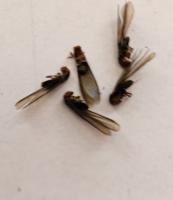Common Termites in Arizona and How To Identify Them

Termites are small, winged insects that are commonly found in Arizona. They feed on wood and other plant materials, converting them into usable food sources. These pests are particularly adept at infiltrating wooden structures, causing potential structural damage. In this article, we will explore the various types of termites commonly found in Arizona and learn how to identify them based on their physical appearance and signs of activity. By understanding the different types of termites, homeowners and property owners can effectively detect and address termite infestations before they cause severe structural damage.
Types of Common Termites in Arizona
Termites are common pests that can cause significant damage to structures in Arizona. There are several types of termites found in the state, each with its own unique characteristics and behaviors. Being able to identify these termites is crucial in order to take appropriate action and prevent further infestations.
Subterranean Termites
Subterranean termites are the most common type of termites found in Arizona. They typically live underground and build extensive mud tubes to connect their colonies to sources of food, like wooden structures. These termites are light to dark brown in color and measure about 1/8 to 3/8 of an inch long. Signs of subterranean termite infestation include mud tubes along walls or foundations, hollow-sounding wood, and discarded swarmer wings.
Drywood Termites
Drywood termites, as the name suggests, infest dry wood and do not require contact with the ground. They are typically larger in size, measuring about 1/4 to 3/8 of an inch long, and have a dark brown head. Drywood termites infest structural timbers, furniture, and other dry wood products. Signs of a drywood termite infestation include the presence of pellets, also known as termite frass, which resembles small grains of sand.
Dampwood Termites
Dampwood termites thrive in moisture-rich environments and infest damp or decaying wood. These termites are larger than subterranean and drywood termites, measuring about 1/2 to 5/8 of an inch long. They have a pale yellowish-brown to dark brown color and often have long wings. Dampwood termite infestations are commonly found in dead trees, desert trees, and moist wood. Look for signs of moist, damaged wood or pieces of wood with smooth galleries as indicators of a dampwood termite infestation.
Understanding the different types of termites commonly found in Arizona, such as subterranean, drywood, and dampwood termites, is crucial for early detection and effective treatment. By being able to identify these termites based on their physical appearance and signs of activity, homeowners and property owners can take proactive measures to protect their structures and prevent severe termite damage.
How to Prevent Termites in Arizona
Termites are resilient creatures capable of causing significant damage to homes and other wooden structures. As common pests in Arizona, it is crucial to be proactive in identifying and preventing termite infestations. Early detection plays a vital role in minimizing the destructive impact these insects can have on your property. By implementing preventive measures and staying vigilant, you can effectively protect your home from termite damage.
5 Steps to Prevent Termite Infestation:
- Remove wood-to-soil contact: Termites require direct contact with the soil to access their food source. Ensure that wooden structures, such as decks or garden beds, are built with no direct contact to the ground. Create a gap of at least 6 inches by using concrete or metal support posts.
- Seal cracks and holes: Termites can enter your home through even the tiniest openings in the foundation. Regularly inspect and seal any cracks, crevices, or holes in your home's foundation to prevent their entry points.
- Maintain proper drainage: Excess moisture attracts termites, making your property more vulnerable to infestations. Ensure proper drainage around your home to prevent pooling water near the foundation. Clear gutters and downspouts regularly to direct water away from your property.
- Monitor the exterior: Conduct regular inspections of the outer areas of your home, including patios, porches, and fences. Look out for mud tubes, which are narrow tunnels made by subterranean termites, as they serve as transportation channels to your house.
- Stay vigilant indoors: Keep an eye out for signs of termite activity inside your home, such as blistering or darkening wood, small holes, or hollow-sounding timber. These are indications of termite damage and should be addressed promptly.
Preventing termites in Arizona is crucial to safeguarding your property from potential structural damage. By taking proactive measures such as eliminating wood-to-soil contact, sealing foundation cracks, and maintaining proper drainage, you can significantly reduce the risk of termite infestations. Regular inspections both inside and outside your home will enable you to catch termite activity early on, allowing for timely treatment and protection against the destructive impact of these resilient pests. Stay vigilant and take preventive action to keep your home termite-free.
Contact the Arizona Termite Experts
If you see signs of termite activity, it is crucial to contact a professional termite exterminator as soon as possible. At Bug Wiser Fumigation and Pest Services, we can assess the extent of the infestation and provide effective treatment options to prevent further damage to your home or property. Taking swift action is key to protecting your investment and ensuring the structural integrity of your property in the long run. Call us today to schedule your free termite inspection.

